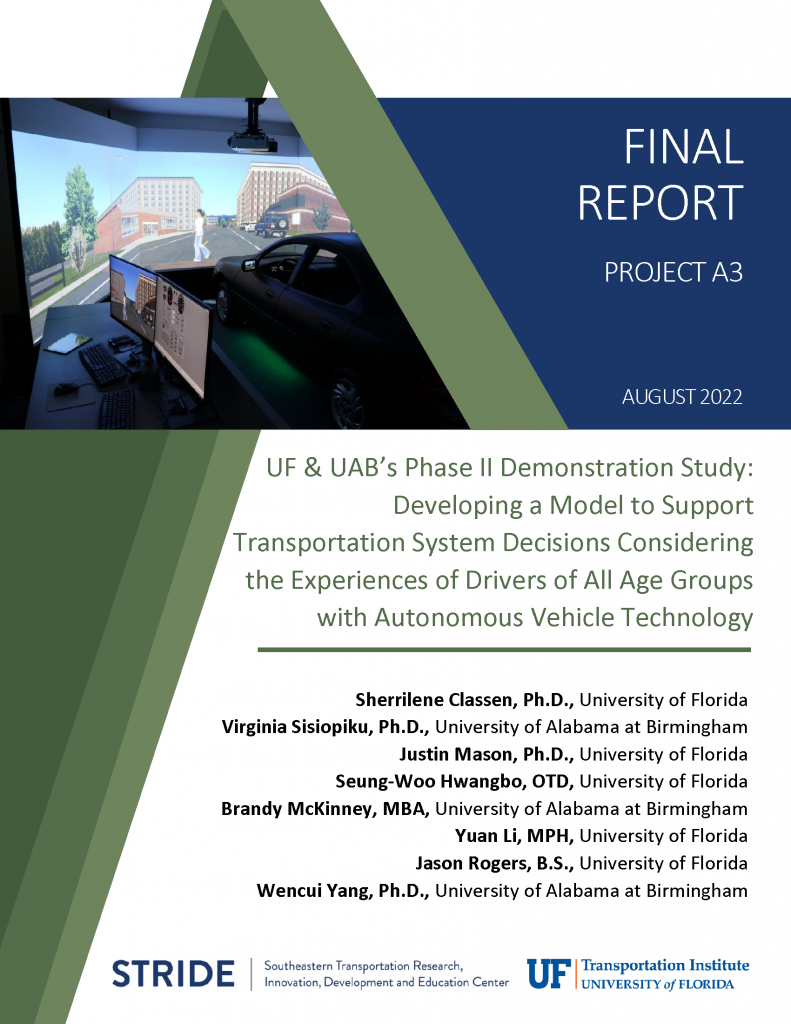UF & UAB’s Phase 2 Demonstration Study: Developing a Model to Support Transportation System Decisions Considering the Experiences of Drivers of all Age Groups with Autonomous Vehicle Technology
Research Team
Sherrilene Classen, Ph.D., University of Florida
Virginia Sisiopiku, Ph.D., University of Alabama at Birmingham
Justin Mason, Ph.D., University of Florida
Seung-Woo Hwangbo, OTD, University of Florida
Brandy McKinney, MBA, University of Alabama at Birmingham
Yuan Li, MPH, University of Florida
Jason Rogers, B.S., University of Florida
Wencui Yang, Ph.D., University of Alabama at Birmingham
- UTC Project Info
- Final Report (view)
- Technology Transfer Report
- Webinar
Abstract:
Using our existing STRIDE Region 4 (UF and UAB) collaboration in UF & UAB’s Demonstration Study (Phase 1) and including stakeholders and industry partners, this project (Phase 2) had two objectives: (1) Quantify the younger and middle-age drivers’ perceptions of AVs before and after “driving” a simulator (Level 4, SAE Guidelines) and after riding in a highly AS (Level 4, SAE Guidelines); and (2) Deliver predictive models of facilitators and barriers from data collected in Phase 1 (older drivers; N=104, Mage= 74.30, SD= 5.95) and Phase 2 (younger and middle-age drivers; N=106, Mage= 36.22, SD= 15.04), combined.
For the second objective, four multiple linear regression models were conducted to predict AVUPS subscales (i.e., intention to use, perceived barriers, and well-being) and the total acceptance score. The four regression models have R2 values ranging from 0.22 (barriers) to 0.36 (well-being). The results of the regression analyses indicated that optimism and ease to use positively predicted intention to use, perceived barriers, well-being, and the total acceptance score. Driving difficulty significantly predicted barriers, whereas miles driven negatively predicted well-being. The regression analysis results indicated that predictors of user acceptance of AV technology include optimism, ease of use, race, and age, with 33.6% of the variance in acceptance being explained by the predictor variables.
The study included three different age cohorts, i.e., younger, middle-age, and older drivers. As such, the findings reveal important foundational information about driver acceptance, their intention to use AVs, barriers to AV technology, and well-being related to AV technology across the driving lifespan. Particularly, our findings have generated new knowledge and documented how demographics, optimism, ease of use, life space, driving exposure, and driving difficulty—not previously examined to this extent in the AV and driver literature—inform the field of the predictors of AV acceptance. We have provided strategies that may inform mobility managers, policy makers, and industry partners alike in improving upon deployment practices of AV technology (autonomous simulator and the AS) for the near future.
